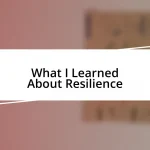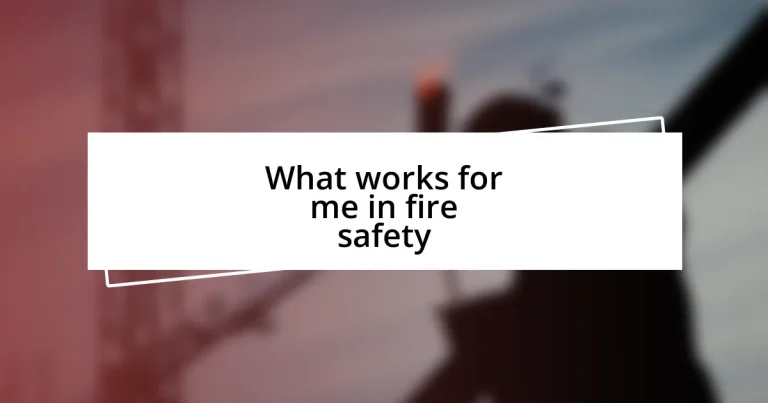Key takeaways:
- Understanding the fire triangle (fuel, heat, oxygen) is crucial for fire prevention.
- Regularly testing smoke detectors and creating an emergency evacuation plan can significantly enhance safety.
- Maintaining a clutter-free environment and conducting electrical inspections helps reduce fire hazards.
- Fire safety training empowers individuals to act confidently in emergencies, including knowing how to use fire extinguishers effectively.
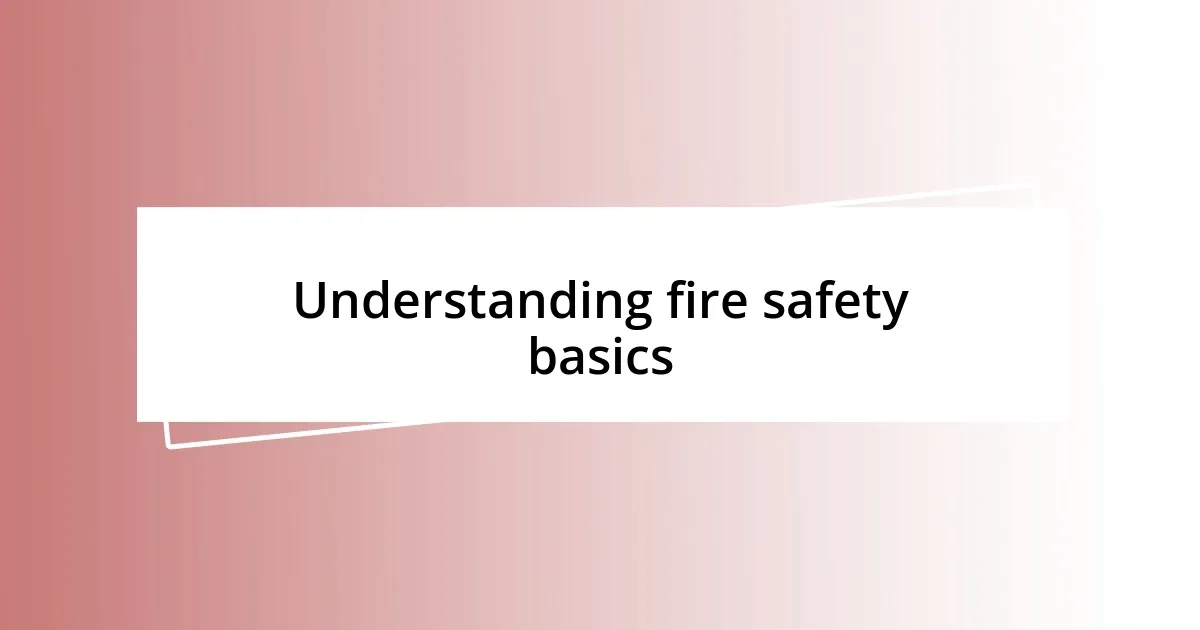
Understanding fire safety basics
Fire safety basics begin with understanding the nature of fire. It’s not just a destructive force; fire needs fuel, oxygen, and heat to thrive. I remember the first time I read about the fire triangle—fuel, heat, and oxygen—it felt like unlocking a secret to preventing fires. Can you imagine the power of knowing that simply removing one of these elements can stop a fire in its tracks?
Another essential aspect of fire safety is having a plan. When I was in school, we had fire drills, which at the time seemed like a nuisance. Looking back, though, I see the value—my classmates and I learned how to exit a building quickly and safely. Do you have a fire escape plan in your home? It’s an exercise that might save lives someday, and I can’t stress enough how important it is to practice it regularly.
Lastly, I always emphasize the importance of having working smoke detectors. I recall a time when a friend’s detector saved their family from a devastating fire in the middle of the night. Just think about it—smoke alarms provide an early warning that can give you those precious extra minutes to escape. Are your smoke detectors tested and ready? It’s a small routine that can make a giant difference in a crisis.
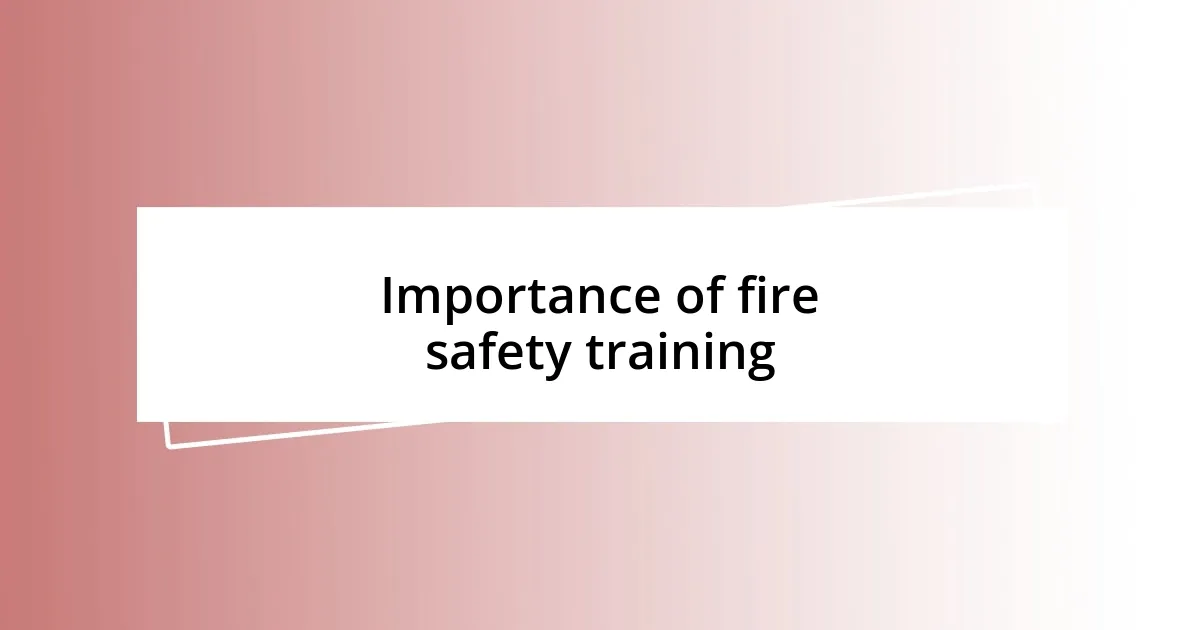
Importance of fire safety training
Fire safety training is essential because it equips individuals with the skills needed to act decisively in an emergency. I remember attending a fire safety course and learning how to use a fire extinguisher. The moment I grasped the PASS technique—Pull, Aim, Squeeze, Sweep—I felt empowered. It’s not just about knowing what to do; it’s about building confidence that can make all the difference during a critical situation.
- Knowledge of evacuation procedures can prevent chaos.
- Understanding fire behavior enhances one’s ability to respond effectively.
- Regular training prepares individuals for the unexpected, reducing panic and hesitation.
- Familiarity with tools like fire extinguishers can save lives.
- A well-trained team fosters a culture of safety in workplaces and communities.
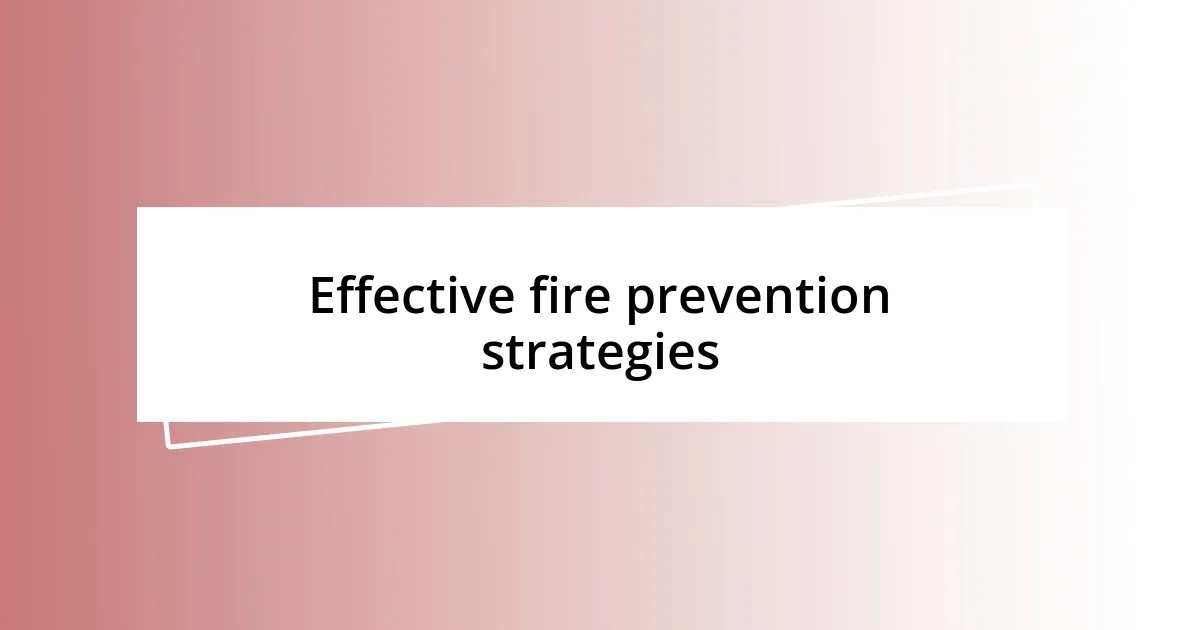
Effective fire prevention strategies
One of the most effective fire prevention strategies I’ve come to rely on is maintaining a clutter-free environment. I remember visiting a friend’s home and noticing the stacks of newspapers and boxes piled in the garage. It dawned on me how easily those materials could ignite if a fire started. Keeping spaces tidy reduces potential fuel for fires, making it a simple yet impactful strategy for fire safety. Have you taken a good look at your surroundings lately?
Another strategy that stands out to me is regularly inspecting electrical systems. I once had a minor scare when I noticed a flickering light. It turned out to be a loose wiring issue that could have escalated. By proactively checking wiring and outlets, we not only prevent potential fires but also ensure the safety of our homes. It’s something I now make a routine part of my household maintenance—easy to overlook but critical to our overall safety.
Fire-resistant materials in homes are also a game-changer. When I upgraded my outdoor decking, I chose composite materials instead of traditional wood. That decision gave me peace of mind, knowing my investment was protected against potential fire hazards. Have you considered how your home’s materials stand up to fire? Sometimes, making such informed choices can make all the difference.
| Fire Prevention Strategy | Why It Works |
|---|---|
| Clutter-Free Spaces | Reduces potential fuel for fires |
| Regular Electrical Inspections | Identifies and mitigates fire hazards |
| Fire-Resistant Materials | Minimizes damage and enhances prevention |
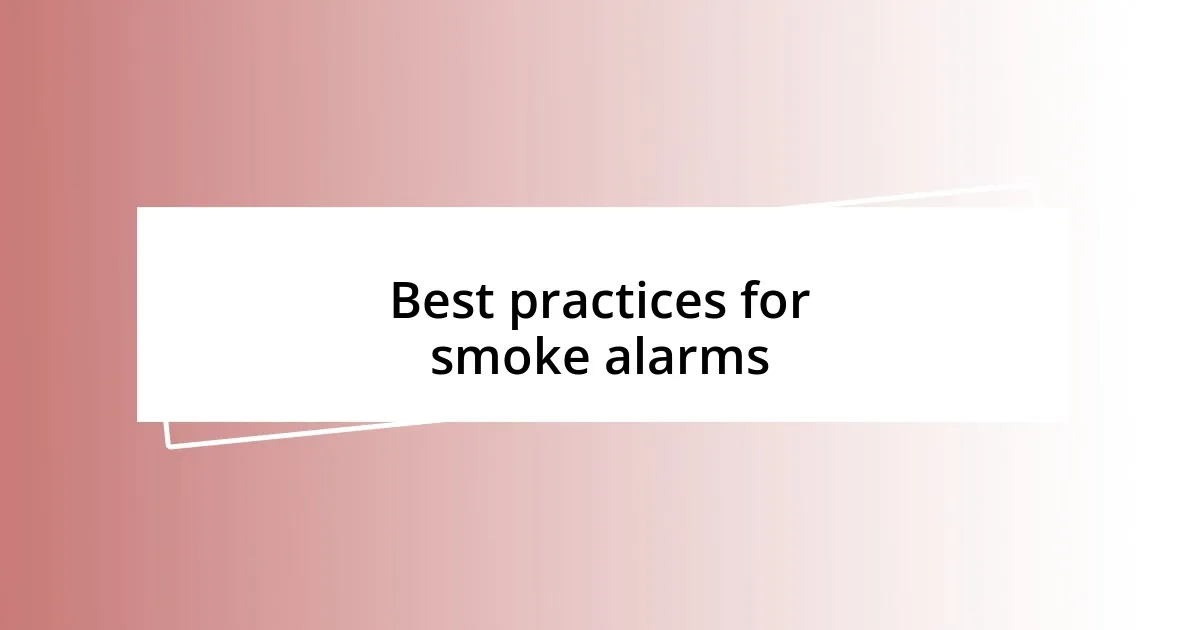
Best practices for smoke alarms
I’ve always considered smoke alarms as my first line of defense against fire. Testing them monthly became a small ritual for me—simple, yet it brings such a reassuring feeling. The day I found one of them malfunctioning was a wake-up call; it hit me just how crucial it is to regularly check that those devices are in good working order. Have you thought about how often you really check yours?
Placement is another key factor that I often discuss with friends. I vividly recall a neighbor whose smoke alarm was stuck in the kitchen, too close to the stove, and it would often go off during cooking. It made me realize that strategic placement makes a world of difference when it comes to reliability. Ideally, smoke alarms should be on every level of your home, especially outside sleeping areas. How does yours stack up in terms of placement?
After experiencing a small scare at my place, I started replacing smoke alarms every ten years without fail. I learned that older models might not perform well when needed the most—imagine realizing your smoke alarm is outdated during an emergency! I marked the purchase date on my calendar as a reminder. This practice gives me peace of mind, knowing that I’m not just relying on something that’s past its prime. How often do you check the expiration date on your alarms?
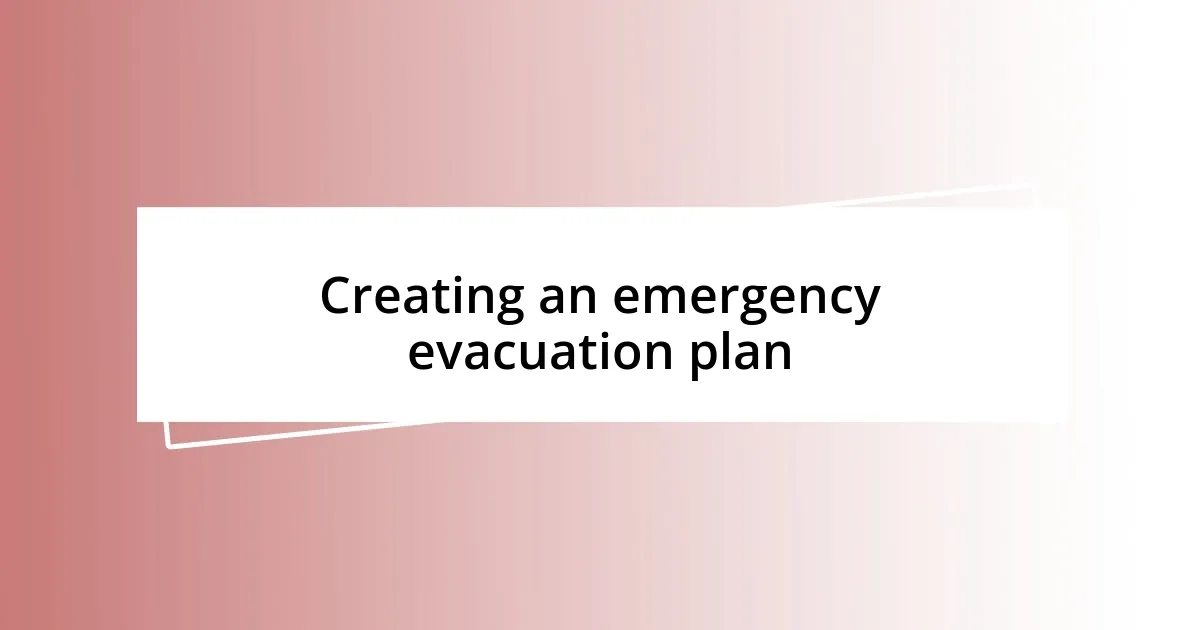
Creating an emergency evacuation plan
Creating an emergency evacuation plan is something I believe every household should prioritize. I remember the first time I sat down with my family to map out our escape routes; it felt surreal but essential. Knowing exactly where to go in an emergency brings a sense of calm that I didn’t expect, similar to having a safety net beneath me.
One crucial aspect I focused on was designating a meeting spot outside the house. After hearing a story about a family that couldn’t find each other during a fire, I understood the importance of having a clear point to regroup. When we practiced our plan, I could see my kids taking it seriously, and it sparked conversations about safety that we wouldn’t have had otherwise. Have you discussed a meeting point with your loved ones?
Additionally, I often suggest conducting regular drills. The first time I did this, I was surprised at how much my family learned about our home. Remembering where to go in the middle of a night was challenging, but it highlighted areas we needed to improve, like having more flashlight batteries handy. What might you discover if you conducted a drill in your own home?
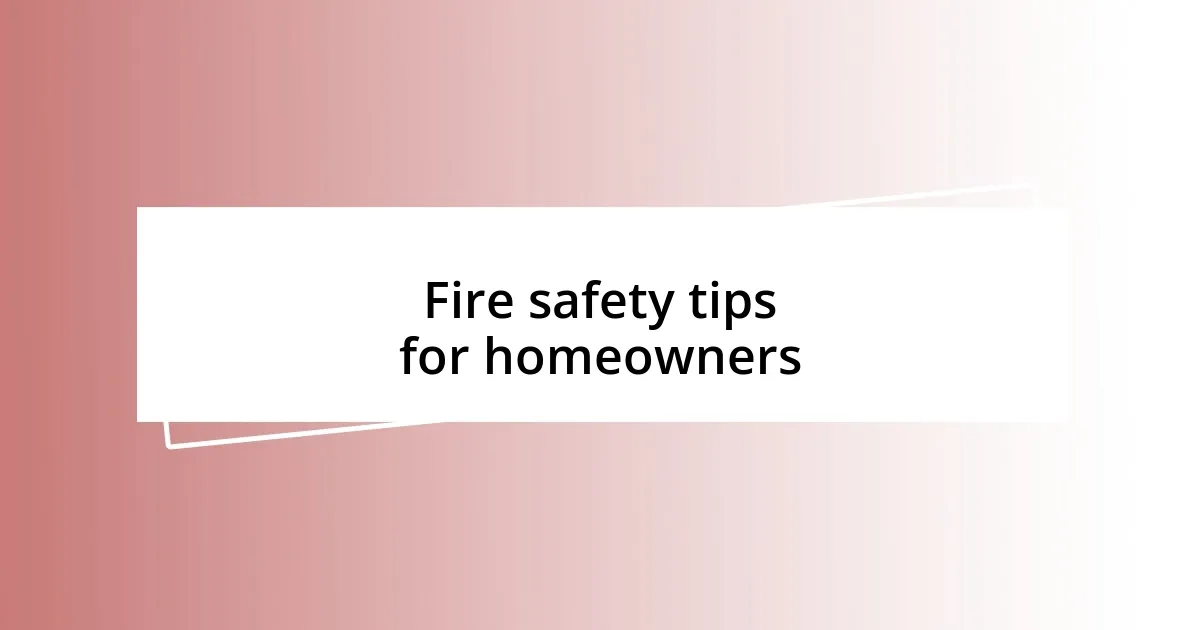
Fire safety tips for homeowners
One fire safety tip I always emphasize is the importance of maintaining clear pathways in my home. I had a friend who experienced a fire, and they mentioned how panicked they became trying to navigate cluttered hallways. Since then, I’ve made it a point to keep exits free of obstacles. It’s a simple step, but it can make a significant difference when seconds count in an emergency. Have you assessed your escape routes lately?
I also believe in the value of educating my family about fire hazards. After watching a documentary on house fires, I was shocked to learn how quickly things can escalate. I gathered everyone for a discussion, and we went over common fire risks, like overloaded outlets and unattended candles. That conversation opened up a dialogue about safe practices, and now my kids remind me when they see something unsafe. What safety conversations have you had with your family?
Lastly, we should never underestimate the power of having a fire extinguisher handy. I once found myself in a situation where a small kitchen fire flared up, and fortunately, my extinguisher was within reach. It made me realize how vital it is to not only possess one but also know how to use it effectively. I’ve since scheduled a refresher course, just to keep those skills sharp. Do you know how to operate your fire extinguisher in a pinch?
